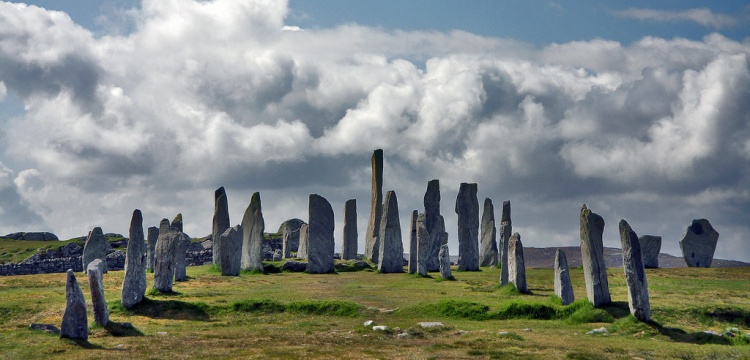Calanais Stones were constructed with astrological phenomena

Commonly, an archaeological monument or series of monuments is identified but little is known about the surrounding areas and, in particular, the palaeo-landscapes within which the monuments are located. This situation is exemplified by the standing stones of Calanais in Lewis. Here, surrounding peat bogs have buried a significant portion of the landscape around which the stones were first erected.
New evidence of a massive lightning strike at the center of a hidden stone circle in the Outer Hebrides may help shed light on why these monuments were created thousands of years ago.
The Calanais Virtual Reconstruction Project, a joint venture led by the University of St Andrews with the Urras nan Tursachan and the University of Bradford, with funding from Highlands and Islands Enterprise, has uncovered a potential link between ancient stone circles and the forces of nature.
While studying prehistoric Tursachan Chalanais, the main stone circle at Calanais on the Isle of Lewis, the project team surveyed nearby satellite sites to reveal evidence for lost circles buried beneath the peat.
One rarely-visited site surveyed, known as Site XI or Airigh na Beinne Bige, now consists of a single standing stone on an exposed hillside overlooking the great circle.
Geophysics revealed that not only was the stone originally part of a circle of standing stones, but also that there was a massive, star-shaped magnetic anomaly in the center—either the result of a single, large lighting strike or many smaller strikes on the same spot.
Project leader Dr. Richard Bates, of the School of Earth and Environmental Sciences at the University of St Andrews, said: "Such clear evidence for lightning strikes is extremely rare in the UK and the association with this stone circle is unlikely to be coincidental. Whether the lightning at Site XI focused on a tree or rock which is no longer there, or the monument itself attracted strikes, is uncertain. However, this remarkable evidence suggests that the forces of nature could have been intimately linked with everyday life and beliefs of the early farming communities on the island."
The researchers were also able to virtually recreate another nearby circle, with the help of the Smart History team based in the University of St Andrews School of Computer Science, which had been lost with its stones either buried or lying flat.
Dr. Bates added: "For the first time in over 4000 years the stones can now be seen and 'virtually' walked around. Everyone will be able to visit this remote site and get a real sense of what it was like just after it had been constructed. We have only just scratched the surface of this landscape and already we can get a feel for what might be buried out there waiting for discovery."
The team hopes to return to Lewis next year to undertake further surveys both on land, and in the waters, around the Tursachan at Calanais, where the old landscape has been flooded by rising sea levels.
Dr. Chris Gaffney, of the School of Archaeological and Forensic Sciences at the University of Bradford, said: "Evidence for such strikes within archaeological surveys is very rare and our work at Site XI demonstrates that without detailed scientific survey we would never be able to identify such events."
Dr. Tim Raub, of the School of Earth and Environmental Sciences at the University of St Andrews, added: "This evidence is rare because lighting strikes are conducted along the top 'skin' of the Earth's surface. The clarity of the strike suggests we are looking at events before the peat enveloped the site, more than 3000 years ago."
Professor Vincent Gaffney of the School Archaeological Sciences at the University of Bradford, said: "The dramatic results of survey on Lewis demonstrate that we have to understand the landscapes that surrounds these ritual monuments and the role that nature and natural events, including lightning, played in creating the rituals and beliefs of people many thousands of years ago."
Dr. Alison Sheridan, Director of Urras nan Tursachan, the Calanais based charitable trust that partnered this research, said: "This is a thrilling discovery that helps us get inside the minds of the people who built the stone circles at and around Calanais. There is much still to find out about the so-called 'satellite' circles of Neolithic Calanais and this provides an important first step. The modelling of Na Dromannan also helps us investigate whether this circle was astronomically aligned."
The findings are published in the journal Remote Sensing.
Source: University of St Andrews [December 23, 2019]
